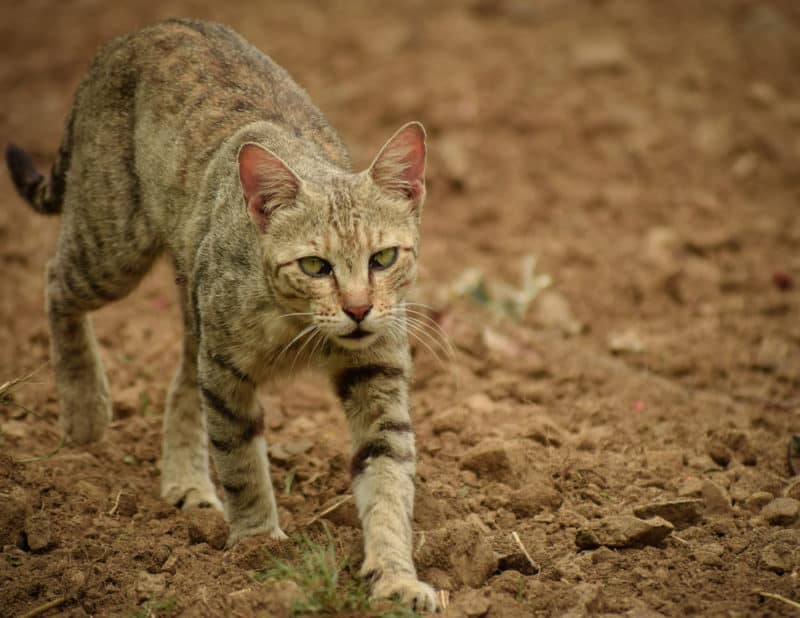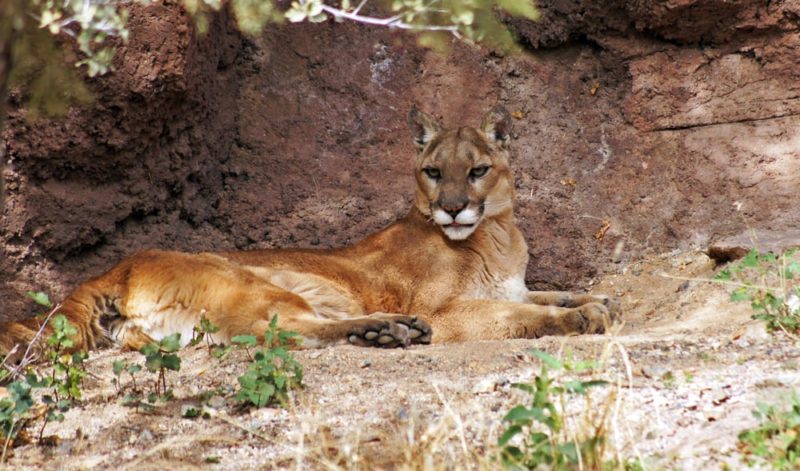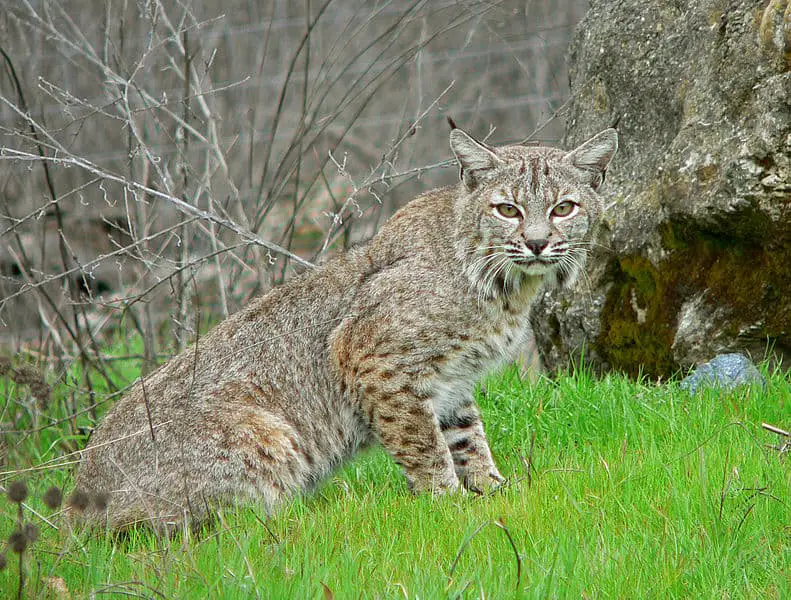Despite reported mountain lion and black panther sightings, according to the Pennsylvania Game Commission, the only species of native wildcats that live in the state are (Lynx rufus) or bobcats.
The last wild mountain lion (Puma concolor) known to live in Pennsylvania was killed in 1871. What’s more, the U.S. Fish and Wildlife Service declared the eastern cougar, other than the Florida panther, extinct in 2011. There is plenty that we don’t know, though. People still report cougar sightings in Pennsylvania all the time. Could there be a cougar population in Pennsylvania? The possibility is there.
As for black panthers, this idea is a little harder to swallow. In the Americas, a black panther would either actually be a melanistic mountain lion or a melanistic Jaguar. There are no known cases of melanistic mountain lions. However, there are melanistic jaguars, but the furthest north that jaguars have been known to range in the 21st century is southern Arizona and southern New Mexico.
Eastern Bobcats in Pennsylvania (Lynx rufus rufus)
The bobcat, which is also known as the red lynx, the bay lynx, or the swamp tiger, is a North American wild cat. Biologists believe that both the bobcat and the Canada lynx are descendants of the Eurasian lynx whose ancestors crossed into North America via the Bearing Sea land bridge.
Where do bobcats live?
Bobcats reside only in North America. Their range begins in southern Canada and then extends south through most of the continental United States and down into central Mexico.
Pennsylvania’s bobcat population numbers over 20,000 animals. Officially, bobcats and feral cats are the only wild cats and the only 2 feline predators in the state of Pennsylvania. According to the Pennsylvania Game Commission, bobcats live in most areas of the state. People rarely see them, though, because they are mostly a crepuscular animal. Your best chances of spotting one are in the early morning and early evening hours.
Other than their inability to cope with deep snow, bobcats are pretty versatile and tend to utilize all the different habitats within their range. You can find bobcats anywhere, from forested mountains to swamps, agricultural areas, and suburban areas with woodlots. They also seem to thrive in wooded areas in close proximity to clear cuts. Studies show that small mammal populations increase in clear-cut areas. This is due to the improved food and cover conditions that a clear-cut creates.
The sizes of home ranges for bobcats in Pennsylvania differ between males and females. Adult males utilize a bigger range than females do, at around 36 square miles. On the other hand, adult females need around 18 square miles.
Sometimes people in rural or even suburban settings have bobcats in the neighborhood, and they don’t realize it. It’s a very rare occurrence, but sometimes these animals will end up in someone’s home or garage. If you ever accidentally corner a bobcat, immediately give it some space. Back away and leave a door open for it to escape on its own. Do not approach a cornered bobcat. These are dangerous wild animals and will do their best to tear you up if they feel the need to defend themselves. If you have an intruding bobcat that won’t leave on its own, call on your local fish and game officer to remove it for you. See also See
What do bobcats look like?
An adult bobcat is similar to their close relative, the Canadian lynx, in appearance with some differences. An Adult bobcat is slightly smaller than an adult Canada lynx.
Compared to Canadian lynx, which thrive in deep snow country, bobcats struggle more in the snow due to the fact that they cannot walk on top of it like lynx can. A lynx’s large paws function like snowshoes keeping it on the snow’s surface. They have evolved this characteristic to hunt snowshoe hares in the winter. On the other hand, compared to lynx, bobcats have small feet that tend to sink into the snow. If the snow is too deep and powdery, it reduces their mobility along with their ability to catch prey.
A bobcat is 2 to 3 feet long and weighs about 15 to 35 pounds. Adult male bobcats are quite a bit larger than females.
These animals have a “bobbed,” short, black-tipped tail with black bands on its upper surface. The black tip on their tail is only on its upper surface but not the back. As opposed to a lynx’s tail which looks like it was dipped in black paint.
Their fur is usually gray to brown, with mottled dark spots that range from black to dark brown on their bodies. They also have black stripes on their inner forelegs and tail.
From a side view, you will notice that a bobcat is slightly higher at the rump than at the shoulders. Bobcats and lynx have long hind legs in proportion to their forelegs.
Bobcats have black-tufted ears. In other words, they have short ear tufts of hair that poke up above their ears and are black at the tips. The backs of their ears, below the black tips, are black. In the center of the black of each ear, they have a single white spot. This gives the impression of a false eye on the back of each ear.
They also have a whiskered face that seems broader due to their long ruffled facial hair and whiskers. Their eyes are yellow with round black pupils.
In 2020, film footage of a rare black bobcat was taken near Danville, Vermont. See. These melanistic bobcats have all the markings that non-melanistic ones do. They manifest as darker black spots on top of lighter black or dark grey.
What do bobcats eat?
Despite their comparatively small size, bobcats are aggressive, tough predators. At times, particularly during the winter, they take larger prey animals that are quite a bit bigger than they are, such as deer. In Pennsylvania, for instance, they sometimes prey on white-tailed deer.
However, their regular diets mainly consist of small mammals, reptiles, birds, and carrion. When they take up residence close to a residential area, their menu might occasionally also include small pets.
They even prey on venomous snakes when the opportunity arises despite not being immune to the venom. They accomplish this by using their quickness to pin the snake’s head down with a paw, after which they dispatch the snake with a quick bite to its spine behind the head.
Reproduction and Life Cycle for Eastern Bobcats in Pennsylvania
Bobcats mate anywhere from late March to early April. During the breeding season, a male bobcat may mate with multiple females. Radio-collared males have been observed to travel up to 20 miles in a single night to get to a female in estrus.
If they successfully mate, the gestation period for bobcats is 60 days.
After breeding, the male and female go their separate ways. Other than in the exceptions of breeding and raising young, they’re solitary creatures.
The female takes all responsibility for the selection of a den site and the rearing of the young.
Bobcats often use rock crevices as den sites but may also den in the cavity beneath an overturned stump or beneath a blown-down tree,
In Pennsylvania, the average bobcat litter size is 3 kittens. However, as few as one and as many as 6 have been observed. See
Bobcat kittens are born with their eyes sealed, just like domestic cats are. However, their eyes will open when they are a week to 10 days old. By the time they are 2 months old, they will have replaced their spotted baby fur with a haircoat similar to what their parents have.
By mid-July, the kittens begin to venture out with their mothers to fine-tune their survival skills. Their training may last into the early winter. By mid-winter, the kittens strike out on their own.
Female bobcats reach sexual maturity at 1 year of age, while males reach sexual maturity at age 2.
In the wild, bobcats live 7 to 10 years. See

Feral Cats in Pennsylvania
Feral domestic cats are an invasive species that threatens populations of native wildlife. For example, the American Bird Conservancy estimates that outdoor cats kill approximately 2.4 billion birds every year in the United States. “Outdoor cats include both feral and domestic.”
The Pennsylvania Game Commission considers feral cats to be a detriment to wildlife, and it’s illegal to release a domestic cat on state game lands. See However, it’s also illegal to harm stray cats. The Pennsylvania SPCA has a program where they trap feral cats, sterilize them, and then turn them loose again. See
The Pennsylvania SPCA has a program where they trap feral cats,
Are There Mountain Lions in Pennsylvania
Bobcats are the only known wildcat species left in Pennsylvania. However, reports of mountain lions are not a rarity in the state. So far, there have not been any substantiated reports of mountain lion sightings
Historically Mountain lions inhabited the keystone state. Pennsylvania State University’s mascot, the Nittany lion, references the cougars that once inhabited the area around Mount Nittany and State College Pennsylvania.
The last known mountain lion in Pennsylvania was killed by Thomas Anson in Berks County in 1871.
However, some people are convinced that a small population of the big cats still exists in some of the state’s remote areas.
Stacey Griffiths, who runs the Central PA Mountain Lion Sightings page on Facebook, and David Foster, who is a biology professor at Messiah College in Mechanicsburg, Pa., sometimes team up to investigate reported mountain lion sightings.
For instance, in 2018, footage from a home surveillance camera in Clarks Summit south Abington township in Lackawanna County came to light. One clip showed a large feline with a long body like a cougar. The long tail, however, was missing from the picture. Even minus the long tail, the animal in the frame looked a lot like a mountain lion. However, the next frame clearly showed that the animal in question had the tell-tale spots of a bobcat. See
Another possible mountain lion incident also occurred in 2018. 2 horses sustained injuries from a predator attack. Foster believes their injuries are more constant with a cougar attack than an attack by a black bear or coyote. See

What do mountain lions look like?
Phenotypically, mountain lions look like giant oversized house cats with short tan hair. One of these animals is much bigger than a domestic cat, though. They are beautiful animals that have lean, muscular bodies, rounded heads, and upright ears that are oval at the tip. They also have a long tail, which is tan with a black tip. Their tail accounts for almost one-third of their entire length. Their long tails help them keep balance.
Mountain lions have an orange-tinged or yellowish-light-brown coat of short, coarse hair that covers most of their body. The area around their nose, the tip of their tail, and the tips of their ears are black. Their belly, the area above their upper lip, lower lip, and chin are all white. They also have a sprinkling of dark hair on their backs. Their coat color varies somewhat in different geographic locations.
Male and female mountain lions are phenotypically identical in every respect except for size. Males are 30 to 40% bigger than females. Though sizes vary considerably throughout the cat’s geographic range, an adult male or tom typically weighs between 110 and 180 pounds, 50 to (82 kgs). A rare few of them grow bigger than 200 pounds (91kgs). Female mountain lions or queens average between 80 and 130 pounds (36 to 59 kgs). Adult males or toms will reach 6 to 8 feet (1.8 to 2.4 M) from their snout to the tip of their tail. On the other hand, adult females are 5 to 7 feet long (1.5 to 2.1 M).
Mountain lions are the fourth largest wildcat in the world. In the western hemisphere, they are smaller in size only than the Jaguar. Worldwide, the African Lion and the Tiger are also larger.
Despite their large size, mountain lions are not taxonomically classified as big cats because they cannot roar. Leopards, for example, are smaller than mountain lions, but since they can roar and cannot purr, they are classified as big cats, while mountain lions are not. Another interesting thing that I can mention here is that mountain lions purr.
Since they purr and cannot roar, mountain lions are in the Felis genus. Meanwhile, big cats, such as the African lion, tigers, leopards, snow leopards, and jaguars which cannot purr and can roar, are in the Panthera genus. “A side note, I listed snow leopards separately from leopards because they are a separate species.”
Where are mountain lions typically found?
Mountain lions live on all three American Continents. Their range begins in the Yukon territory of Canada in the north and extends down through parts of North America, Central America, and South America to Argentine Patagonia in the south.
The biggest populations in Canada are in British Columbia and Alberta. On the other hand, in the U.S., they mainly live in the western states and Florida. The people of Florida call this elusive cat the Florida Panther.
Do mountain lions ever harm humans?
The following section is from another one of my blog posts entitled “Are Mountain Lions Dangerous?” Found here.
Fatal mountain lion attacks on humans are extremely rare. In fact, there are only 20 records of fatal mountain lion attacks on humans in all of North America in the last 100 years. Don’t let that fact lull you into a complete sense of false security, though. There have been many more mountain lion attacks over the years that didn’t result in a fatality. Mountain lions are, in fact, dangerous.
A mountain lion is a formidably tough wild predatory animal. They can run 40 to 50 miles per hour for short bursts. Additionally, they can leap 18 feet vertically and 40 feet horizontally to catch their prey. These ninja-like predators typically stalk their prey from behind and then leap on an animal’s back. They then crush their cervical spine or larynx with their powerful jaws. They have a bite force of 750 pounds per square inch.
Some factors that cause mountain lions to attack humans
The majority of the time, mountain lions use their ghost-like skills to avoid human contact. On rare occasions, though, they attack humans. Below are a few of the reasons why.
- If the cougar has an injury or some sort of impairment that prevents it from killing its normal prey, it’ll be more likely to look at a person as potential prey.
- Male mountain lions engage in fights for territory. Some of their battles are to the death. A percentage of cougar attacks on humans are perpetrated by hungry semi-juvenile toms that have been kicked out of territories with a more abundant food supply.
- Scientific data suggests that mountain lions that were orphaned at a young age are more likely to attack humans. This is possible because they missed the part of their training where their mothers taught them that humans are to be feared.
I don’t intend to scare the reader from being outdoors. Mountain lion attacks on humans are extremely rare. The drive you take to get into mountain lion country is statistically much more dangerous than being there is. However, you shouldn’t be so naive as to think that bad things never happen. Here is an occurrence that recently happened in Utah.
Recent Posts
The only venomous snakes in Washington State are Northern Pacific Rattlesnakes. The Northern Pacific Rattlesnake (Crotalus oreganus oreganus) is a sub-species of the Western Rattlesnake. Anyone...
Skunks are not classified as true hibernators. But they go into a state of torpor when the weather gets cold. Skunks are light sleep hibernators, along with opossums, bears, and raccoons. ...

